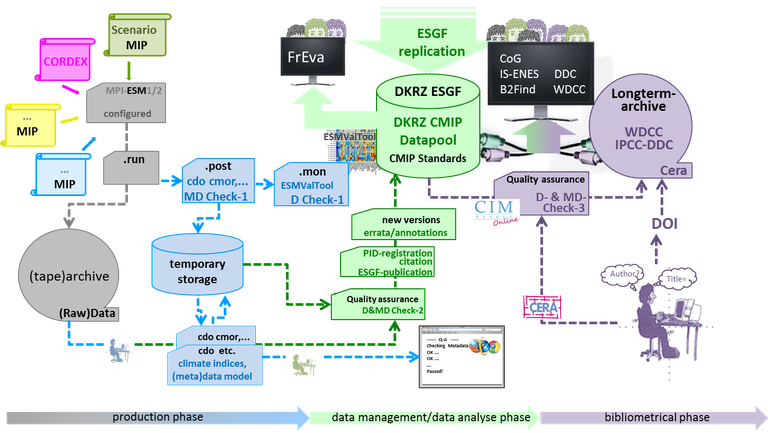Data Workflows
The main objectives of subproject 1 (TP1) in CMIP6-DICAD are the provision of the German contribution to the data base for the next assessment report of the Intergovernmental Panel for Climate Change (IPCC/AR6), the capacity building with respect to data formatting according to the CMIP standard, as well as the generation of climate change data within the framework of the CMIP6 endorsed ScenarioMIP.
Therefore, the scope of TP1 encompasses large parts of the entire workflow starting by running CMIP6 experiments, followed by data post processing, quality assurance, data publication, up to long-term archiving in the WDCC or DDC archives including DataCite DOI assignment.
The workflow steps which will be supported in TP1 are displayed in the figure. The workflow steps dyed grey represent the configuration of the ESM models according to the specifications of the CMIP6-supported MIPs (colored paper rolls). The model results are either diagnosed (.post) in parallel with the model integration and published directly in the ESGF data nodes at the DKRZ from a temporal storage device. This workflow branch is called 'operational'. The temporal storage is required in order to allow for the required quality control before the ESGF publication. Optionally, the data can first be written into a (tape) archive, and can be processed after partial or complete model integration. This procedure is called 'interactive'. It is more likely to be used for experiments whose data processing has been performed incorrectly or not completely during the model run. The workflow steps of both options, operational and interactive data processing are colored in blue.
The green workflow steps represent the data management part of the workflow, i.e. the transfer of data into the CMIP data pool through a primary publication after passing the quality control or as replication of data from other ESGF nodes. The replication allows to use the ESMValTool for a timely diagnosis of the CMIP6 model ensemble. The data in the CMIP pool can be accessed via the CoG, IS-ENES, or B2Find portals, and after long-term archiving (violet workflow steps) via the WDCC and DDC portals.

